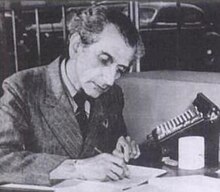Cornelius Lanczos
| Cornelius Lanczos | |
|---|---|
 |
|
| Born |
February 2, 1893 Székesfehérvár |
| Died | June 25, 1974 (aged 81) Budapest |
| Nationality | Hungarian |
| Fields |
Mathematics Theoretical physics |
| Alma mater | University of Szeged |
| Doctoral advisor | Rudolf Ortvay |
| Other academic advisors | Loránd Eötvös, Leopold Fejér, Franz Himstedt, Erwin Madelung |
| Known for | Lanczos algorithm |
| Notable awards | Chauvenet Prize (1960) |
Cornelius (Cornel) Lanczos (Hungarian: Lánczos Kornél, pronounced [ˈlaːnt͡soʃ ˈkorneːl], until 1906: Löwy (Lőwy) Kornél) was a Jewish Hungarian mathematician and physicist, who was born on February 2, 1893, and died on June 25, 1974.
He was born in Székesfehérvár to Karl Löwy (Lőwy Károly) and Adél Hahn.
Lanczos' Ph.D. thesis (1921) was on relativity theory. In 1924 he discovered an exact solution of the Einstein field equation, which represents a cylindrically symmetric rigidly rotating configuration of dust particles. This was later rediscovered by and is known today as the . It is one of the simplest known exact solutions in general relativity, and is regarded as an important example, in part because it exhibits closed timelike curves. Lanczos served as assistant to Albert Einstein during the period of 1928–29.
He did pioneering work along with G.C. Danielson on what is now called the fast Fourier transform (FFT, 1940), but the significance of his discovery was not appreciated at the time, and today the FFT is credited to Cooley and Tukey (1965). (As a matter of fact, similar claims can be made for several other mathematicians, including Carl Friedrich Gauss.)
Working in Washington DC at the U.S. National Bureau of Standards after 1949, Lanczos developed a number of techniques for mathematical calculations using digital computers, including:
...
Wikipedia
